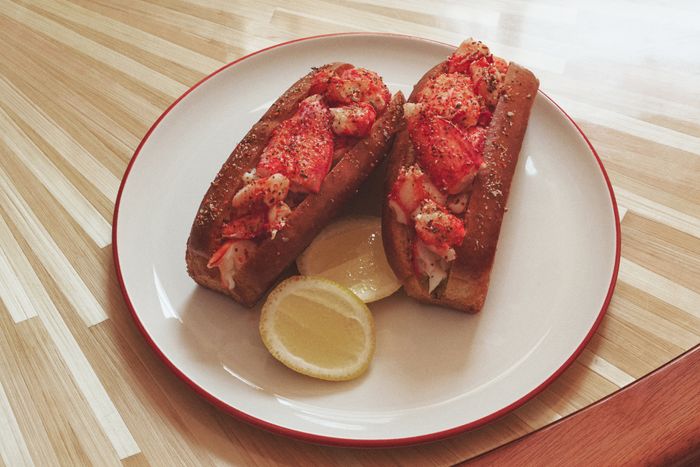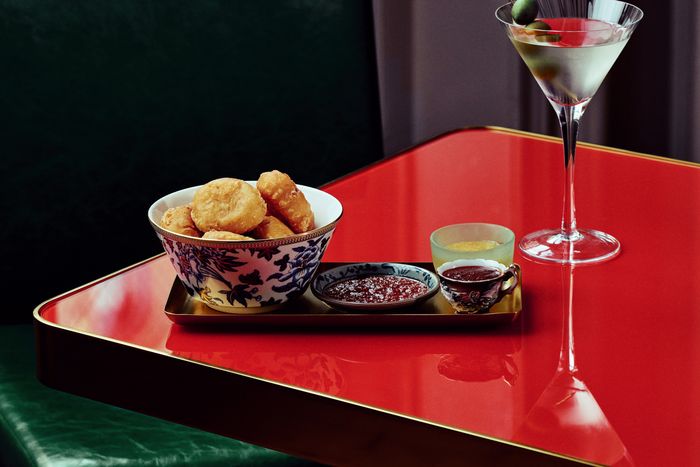Crab agnolotti, swordfish au poivre, and a lobster roll at the Otter.
Photo: Yudi Ela
The most important thing to know about the lobster roll that Alex Stupak will make at his new seafood restaurant, the Otter, is that it is, in his words, “not creative.” Each roll starts with a one-and-a-half-pound lobster, broken down into tail, knuckle, and claw meat. The shell is used to infuse lobster butter, to dress only certain parts of the meat. The tail is left unbuttered and gets tossed with mayonnaise. Each layer is then precisely ordered into a toasted bun that’s lined with thin slices of celery that have themselves been dressed with salt, sugar, citric acid, and “a little turmeric for that electric-neon Ecto Cooler color.”
To be fair, for Stupak, a lobster roll with multiple levels of deconstruction and reconstruction and a housemade shell-butter is sort of straightforward. He’s best known as a pastry chef who pioneered twistable columns of chocolate ganache and for his empire of Empellón restaurants. There, he once used a Jean-Georges Vongerichten scallop dish, set within a tortilla, to make a point about how New Yorkers baselessly viewed Mexican food as being worth less money (“as elegant a piece of intellectual grenade-throwing as I’ve ever seen in a restaurant,” wrote Pete Wells). Most recently, Stupak made headlines with his $29 hot dog, another dare to the public: expensive ingredients stuffed into a much-connoting shape, to shift and twist perceptions.
Yet in person, Stupak is not the brooding, overproud modern chef bro; his vibe is more rapidly pontificating Adam Scott than Carmy-intense Jeremy Allen White. He is aware of his own wit, burying Easter eggs within all of his menus, but doesn’t want to force anything heady onto diners. “Ninety-nine point nine nine percent of people are going to watch the movie,” he says, “but .01 percent of people want to hear the director’s commentary.”
Stupak’s lobster roll.
Photo: Yudi Ela
Two years ago, when he first started planning the menu for the Otter (opening tonight, September 23, and named, he says, because it’s a cute animal that eats a lot of seafood), he wrote down one word: seduction. His friend Amar Lalvani — the executive chairman of Standard International — had asked if he’d ever be into doing a seafood restaurant for a new hotel project. That got him thinking. “‘Seafood restaurant’ sounds limited, but it’s the broadest category of restaurant. Is it Le Bernardin? An omakase counter?” Or, in this case, a restaurant that takes at least some of its inspiration from a more humble New England seafood shack. “I want people to fall in love with it and not know why,” he says. “Seduction sneaks up on you.”
That may explain how a double cheeseburger made its way to the menu — with remoulade instead of special sauce to help maintain the thematic through-line. But despite the burger, and the Otter’s location inside Soho’s new Manner Hotel (rooms starting at $899), the Otter is very much not a “hotel restaurant.” It’s a real restaurant that happens to be in a hotel, and it will give Stupak’s droll humor a chance to wind through a new genre.
Take, for instance, the shellfish platter. The presentation, on a bed of ice, recalls one of his Empellón desserts, a fruit platter that was itself modeled after a tray of oysters. Unlike the many-tiered towers across the city, this one expands outward, not upward, as diners double or triple the contents. Each item is a composed mini-bite. An oyster gets a brat-green crown of cucumber cream, while cold-smoked salmon panna cotta is topped with wasabi and trout roe. (Each piece is flavored with Japanese ingredients refracted through a theory Stupak has about how many New Yorkers eat sushi: “A lot of us just really enjoy the flavors of soy sauce and wasabi.”)
Then there is agnolotti, pasta that Stupak says plays off of “one of the two ways we know how to cook seafood in New England — bury it under a buttery mound of Ritz and parsley and throw it in the oven.” He fills each pocket of dough with parsley-root purée, tosses it with crab, and — yes — tops it with Ritz crackers.
There is surf ’n’ turf (dry-aged strip with crawfish béarnaise) as well as turf ’n’ surf (swordfish au poivre, cooked in a sauce of beef stock, red wine, cream, and shallots that takes three days to prepare) and clam chowder wherein every ingredient is meticulously chopped so that every spoonful can contain bits of it all.
The nautical theme is subtle but perceptible. The restaurant, on the ground floor of the hotel, has glossy navy walls and two large skylights that make it feel like a posh London wine bar grafted onto the bottom level of a large sailboat. An Elvira Solana mural stretching across several walls depicts a journey from forests upstate to Manhattan and out to Montauk; an oversize fireplace anchors the room.
Along with executive chef Brian Sernatinger and chef de cuisine Michael Thomas, Stupak will also handle the menu for an upstairs cocktail bar named Sloane’s. Stupak says he was inspired by the time he visited the home of Julia Child when she served him Champagne paired with Goldfish crackers. Here, that approach translates to martinis alongside chicken nuggets made from a pâté of thigh meat, breast meat, skin, white pepper, and shio koji, which Stupak fries and freezes several times until they’re as crispy as the fast-food version.
At Sloane’s, a martini with nuggets.
Photo: Yudi Ela
Stupak, a fan of David Lynch, compares the project to Twin Peaks in its postmodern approach: “This is a mix of everything people loved at the time, all on the menu; I can have a burger and pasta and sashimi flavored with soy, and it works.”
His greatest hope for the restaurant is that it becomes someone’s favorite place, not just someone’s favorite place for seafood. Dessert — also headed up by Stupak — will bring pistachio tiramisu, “really big bowls of ice cream and sorbet,” and a lemon-curd rice pudding topped with spheres of golden raisin paste that are as “chewy as a Hi-Chew.” Finally, there is the recipe that Stupak spent the most time developing, a version of Boston cream pie made of Japanese-style sponge cake and an emulsion of buttercream, whipped cream, and pastry cream perfumed with Kirsch and orange blossom in a nod to tarte Tropézienne. The dessert speaks to Stupak because he loves things that are not what they declare themselves to be — and Boston cream pie is always, after all, actually cake. “The real win,” he says, “is when you can give people something they don’t know they want.”
See All


